- All Posts
- /
- Email marketing KPIs: This is how to use them

Email marketing KPIs: This is how to use them
Data Management-
 Stephanie Knapp
Stephanie Knapp
-
Updated:Posted:
On this page
Coming up with your lifecycle email marketing strategy and getting great emails into customer inboxes is only part of the email marketing equation.
If you want to make the most of your email efforts and continuously improve, you need to track performance.
Email marketing KPIs, or key performance indicators, are metrics used to assess customer reactions to emails. How do you measure email performance with KPIs? There are a few schools of thought.
Typical campaign-centric email marketing KPIs
If you’ve read any other blog posts on marketing KPIs, you’ve likely encountered “campaign-centric” tracking. This method of looking at single, straightforward metrics is universal — but somewhat limiting in the insights it delivers.
Customers don’t interact with or think about your company as separate marketing channels or individual email campaigns.
So why would you track email performance in such silos?
That said, campaign-centric email analytics are helpful, but they always need to be considered in the wider context of all of your users’ interactions. For example, analyzing open rates may tell you a little bit about customer preferences, but the insights might not expand much further than your subject line writing.
Typical campaign-centric KPIs include:
Email delivery rate. Your delivery rate, not to be confused with deliverability, lets you know what percentage of subscriber email servers have accepted your email for delivery. A failed delivery is a bounce, and tracking delivery rates is an indicator of list health.
Unique open rate. Open rates are one of the most widely available email marketing KPIs and are easy to find on all ESPs. This KPI tells you what percentage of people who received the email actually opened it.
Click-through rate. After open rates, click-through rates are a standard email marketing KPI. The click-through rate shows what percentage of people who opened the email click through to your website.
Conversion rate. If you set up a third-party analytics tool, such as Google Analytics, you can track customer conversions from emails. You can also use platforms like Vero to automatically attribute desired actions to the campaign the end-user receives.
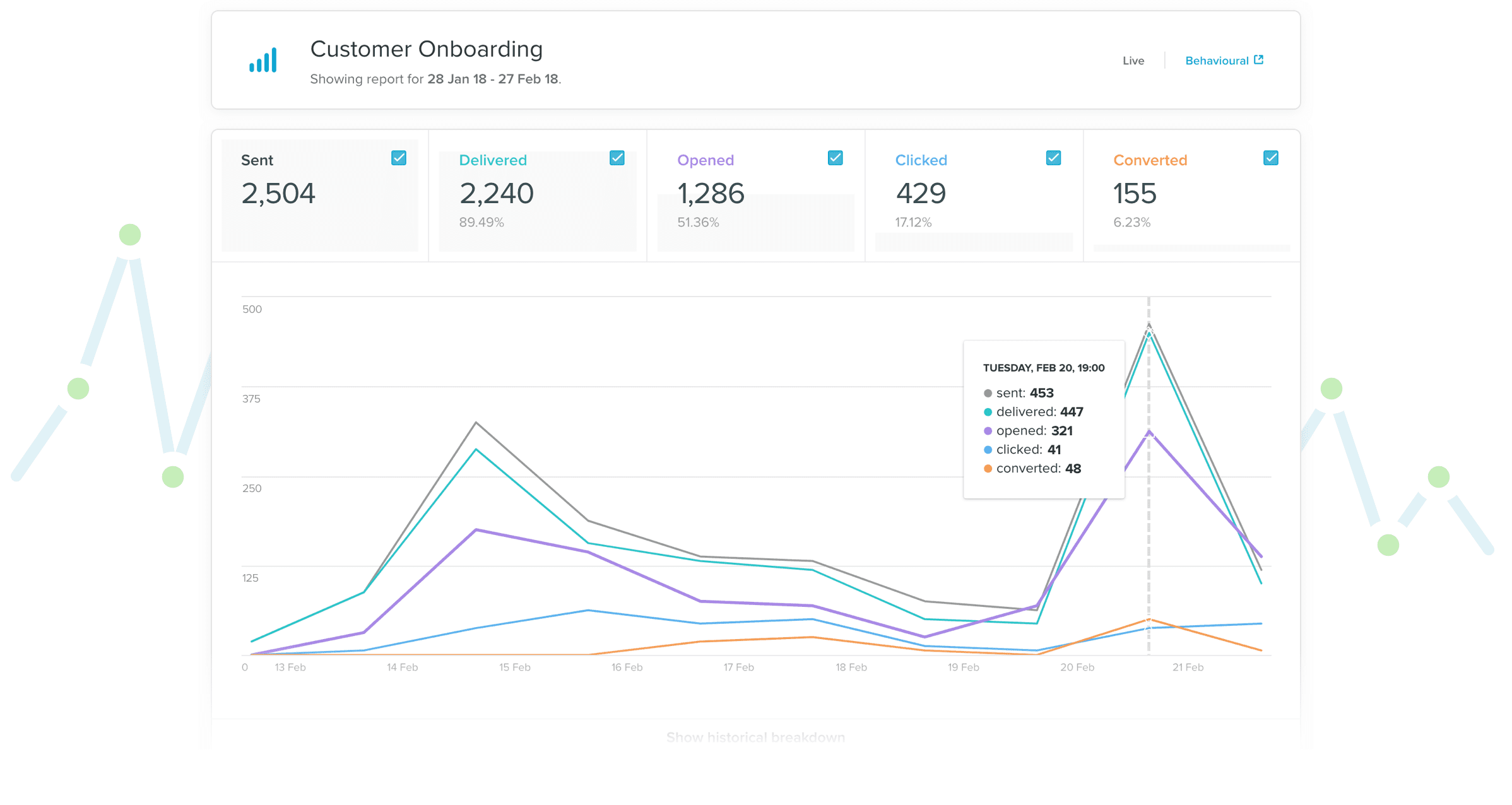
So how do you use email marketing KPIs to inform future campaigns and marketing decisions? It begins with understanding the email marketing funnel in totality. If you’re familiar with lifecycle marketing, then you already have a basic understanding.
The email marketing funnel is a way to organize which KPIs are most important, depending on the customer relationship and goal. For example, it’s unlikely that a brand new subscriber is going to convert on the first email.
Therefore, tracking the conversion rate on emails designed for the “awareness” or “engagement” phase of the customer journey could be misleading.
For example, the welcome email from Lush is focused on introducing the brand and getting new subscribers to follow company socials. While it’s possible the new subscriber might click through and make a purchase, that isn’t the main goal of the email.
For an email like this, tracking click-through-rate and tracking their engagement with content is much more relevant.

Here’s a breakdown of some of the key phases of the email marketing funnel, along with the KPIs you’ll use along the way.
Awareness: The awareness stage is the very beginning of the relationship between your company and the potential customer. The best marketing KPIs to know here are opt-in rates for lead magnets or new newsletter subscribers. This is the widest point in the funnel.
Engagement: During the engagement phase, you want to use email to encourage people to interact with your brand. Look at open rates for new subscribers, and see how they change over time for each person. You also want to drive click-throughs at this point.
Purchase: The email KPI goal is clear during the purchase stage—you want a conversion!
Retention: Email marketing success during the retention phase is focused on consistency and longevity. Declining open and CTRs can signal trouble in paradise. Engagement time within your emails is also important.
Growth: The growth stage is focused on upsells and cross-sells, so conversion rates can come into play again. Also, look at what types of content your customers are showing interest in, as it can help with segmentation.
Advocacy: During the advocacy stage, you want to monitor response rates to emails asking for reviews or feedback. You can also track the success of “refer a friend” program emails.
Below is a visual overview of the email marketing funnel, along with the key metrics that you should track at each stage.
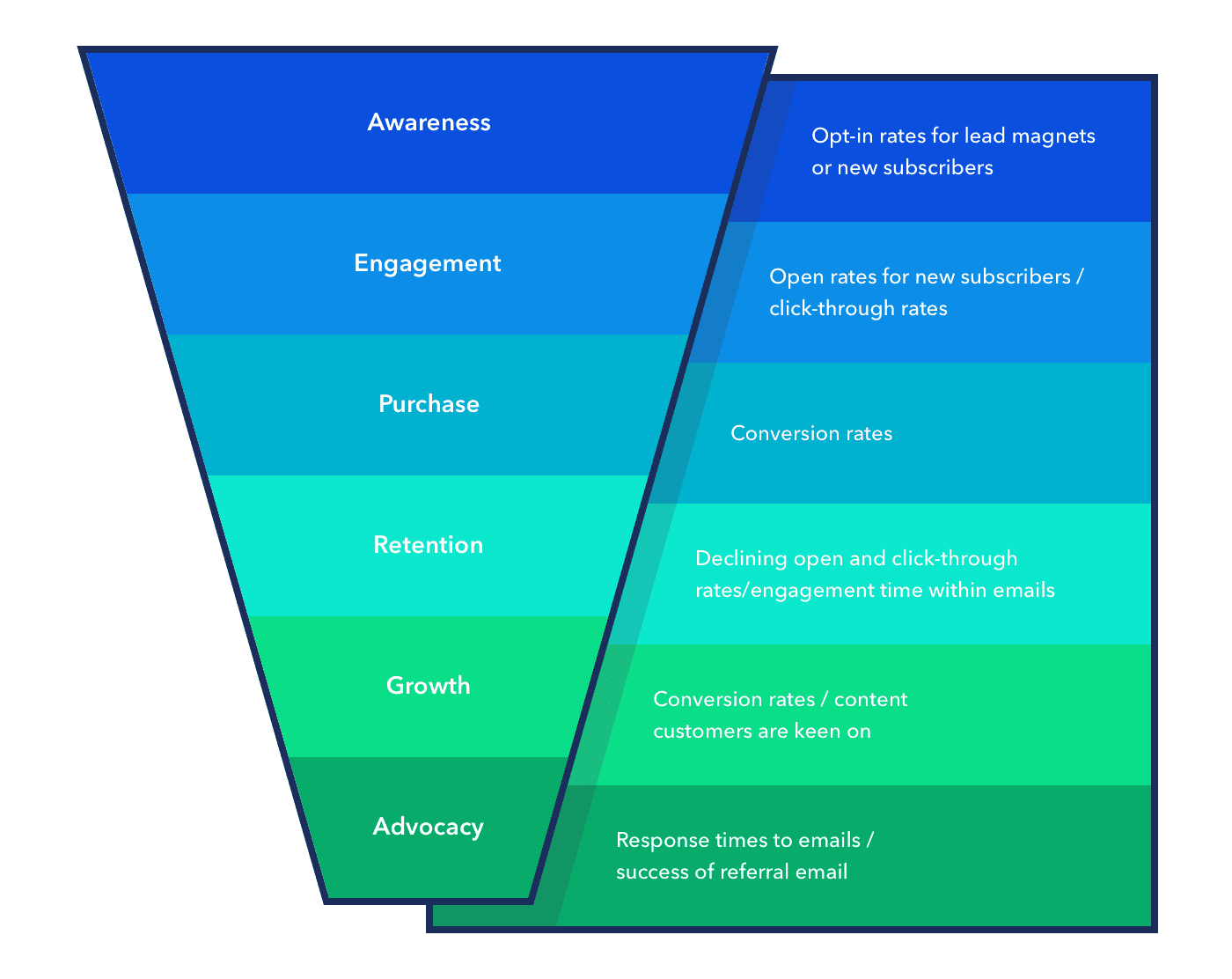
Why you should use a ‘user-centric’ lens for KPI analysis
The email marketing funnel is a useful framework for thinking about the transformation a customer goes through. However, there can be many factors affecting your customer’s experience and perspective.
Not everyone’s journey to your email list is the same
While it’s most often the case that a new email subscriber is in the “awareness” stage, a person’s placement in the funnel isn’t absolute. For example, a new email subscriber may be a long-time social media follower who is just about to move into the “purchase” phase.
What does this all have to do with email marketing KPIs? Taking into consideration the nuances of a customer’s experience adds a “user-centric” lens to your email analysis.
So you need to consider all customer interactions
Being user-centric means analyzing not only where in the email marketing funnel they may be, but also the other marketing channels they’re being exposed to.
Rather than looking at a very specific metric on a single email, such as the open rate on the second email in your welcome sequence, you’ll zoom out to view marketing performance holistically with a user-centric approach.
Use segmentation and cohorts to analyze campaign performance
Using tools such as cohort analysis and segmentation, you can learn and interact with customers in a way that aligns with their reality—not your expectations. You can also take a user-centric approach to KPIs by considering the context of each metric.
Also Read: The best way to organize your marketing stack
Let’s look at an example where being user-centric can help you analyze email performance. The email below from Blume is promoting two acne-fighting skincare products. While you could monitor CTR and conversions for everyone who received the email, there are some user-centric “filters” you could use in your analysis.
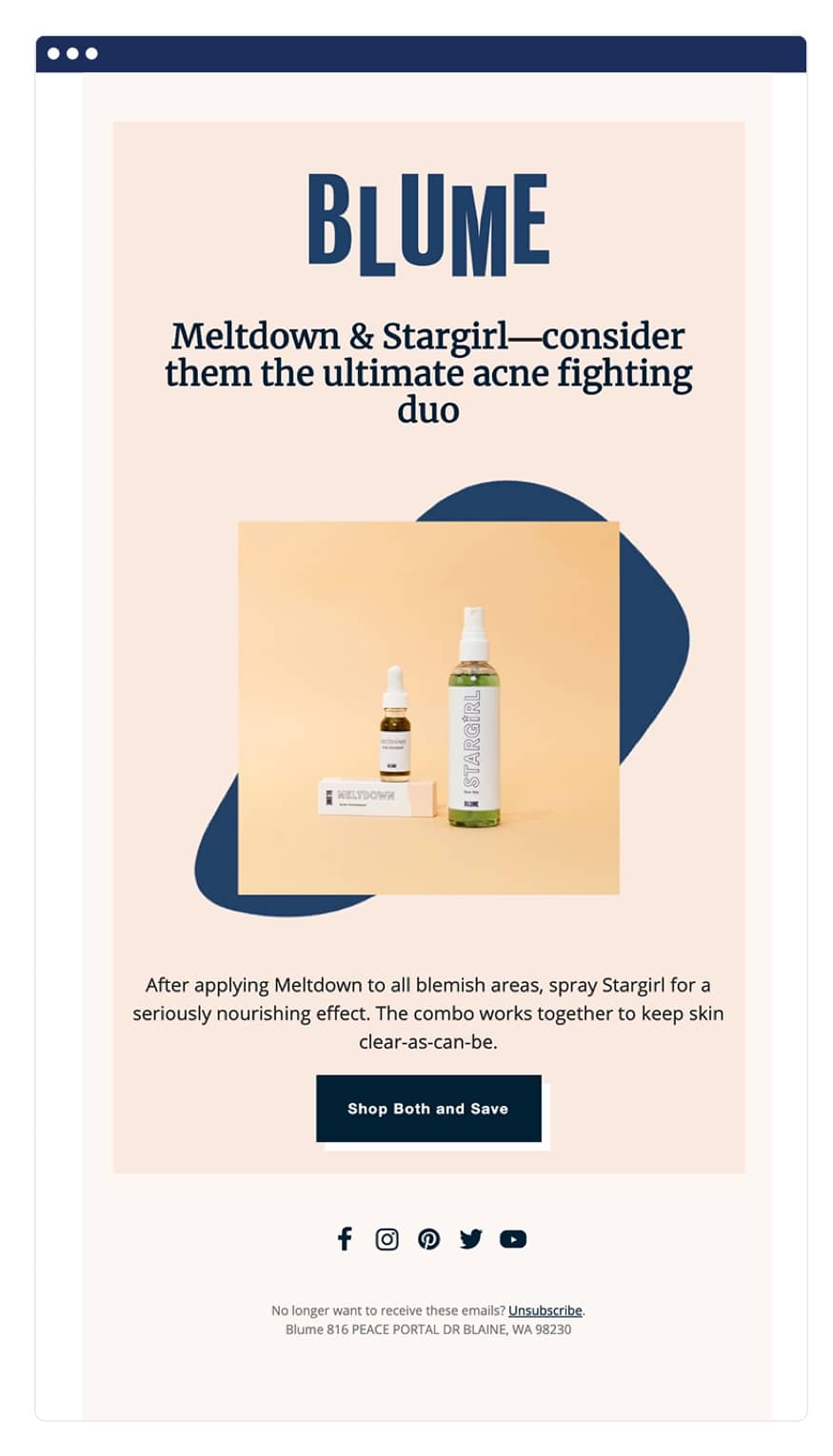
For example, what if you added a tag to users who had shown interest in acne-fighting content? You could then see how the email performed with a segment that could most benefit from the product.
By considering email metrics alongside other customer actions, you can begin to understand the context of how a subscriber moves from a browser to a buyer.
Let’s explore what being user-centric means in practice.
Number of active subscribers
For email marketers, a growing subscriber list is a dream. However, you should compare your total number of subscribers to the active portion.
Why should you track active subscribers? Failing to consider what percentage of subscribers are active and engaged can skew your other metrics. For example, you may be discouraged to see low open rates. However, open rates may be very high among particular segments, while cold subscribers are bringing the average down.
When is looking at active subscribers most useful?
- Using this metric on transactional emails like order confirmation emails helps you to identify your most engaged customers.
- While promotional emails or newsletters may have high open rates or readers, transactional emails shine a light on people who are engaging with your company in a meaningful way.
- Transactional emails occur after a very specific, and vital, type of engagement, such as placing an order or upgrading to a paid plan, and this context gives you an accurate representation of active subscribers.
If you want to get a count of active subscribers, look at how many order confirmation emails you’ve sent! A transactional email, like the one from Chewy below, can act as an arrow pointed straight at users who are taking important actions.
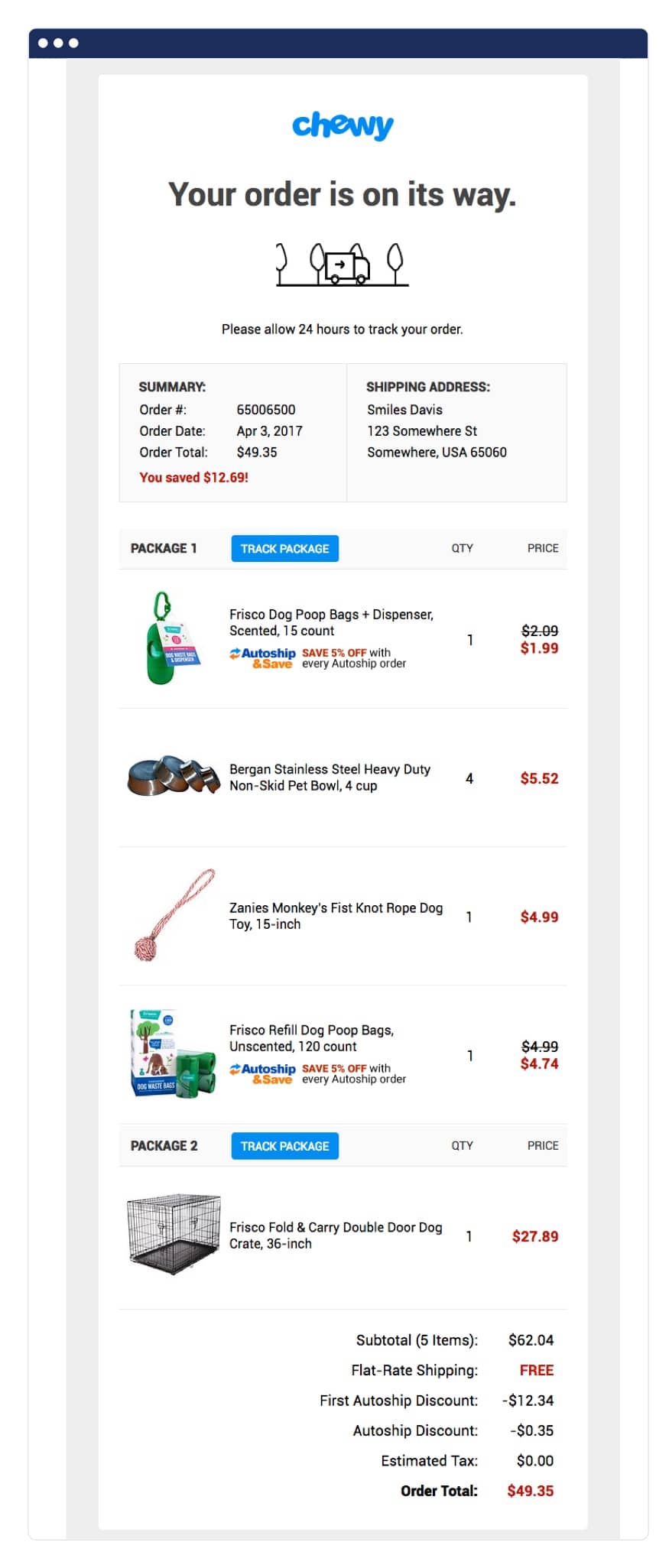
Other ways to use active subscribers as a metric
- You can also use your number of active subscribers to analyze how promotional pushes perform between segments, or how well your re-engagement or winback emails lead to increased activity.
- Considering volume metrics, such as active subscribers or click-through rates, is most powerful when you’re comparing groups of subscribers or contextual shifts in engagements.
Number of new recent subscribers
If you see a surge in email subscribers, it’s worth investigating. Why are new subscribers worth tracking? This email metric helps analyze the effectiveness of non-email, acquisition-focused marketing channels. You should also watch this email marketing KPI when you create referral programs, since new subscribers may end up on your list thanks to current advocates. When is using new subscribers as a metric most useful?
- Look at what a person did just before and after signing up to understand what channel or type of content brought them to your list
- Analyze the effectiveness of acquisition tactics, such as referral emails, by monitoring interactions in the days after signing up
Each time someone signs up from a referral you can send them a specific email, such as the one from Remote.com below. You can track actions and conversions for users who received this email to gauge referral lead quality. You could also compare the number of referral emails you sent out for existing customers to referral signups.
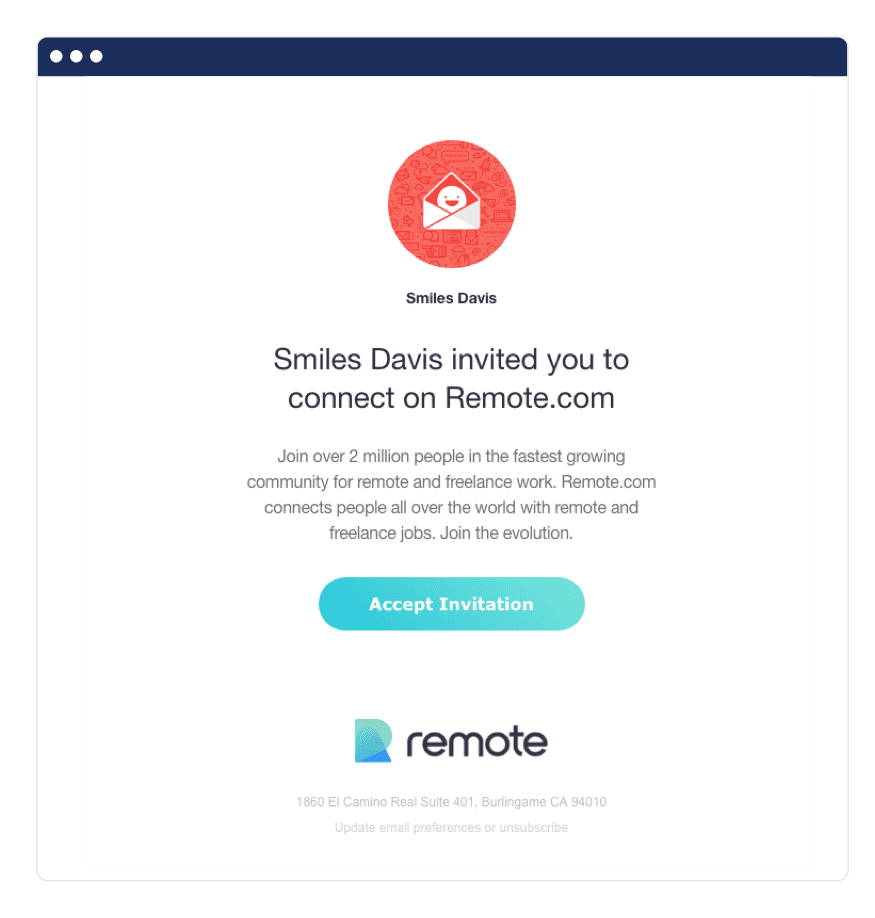
Messages per subscriber
Email frequency is a bit of a goldilocks situation. If you send too many, you risk annoying subscribers. However, sending too few may result in people forgetting you exist.
Why are messages per subscriber worth tracking?
This KPI is useful for promotional emails, which can get overwhelming in large quantities. Look at different user segments and make sure they’re getting a mix of email types.
The Skillshare email below is an example of a promotional email that you’d want to track frequency. If you send too many promotions to a single user or segment very close together, then discounts begin to look like “the boy who cried wolf.”
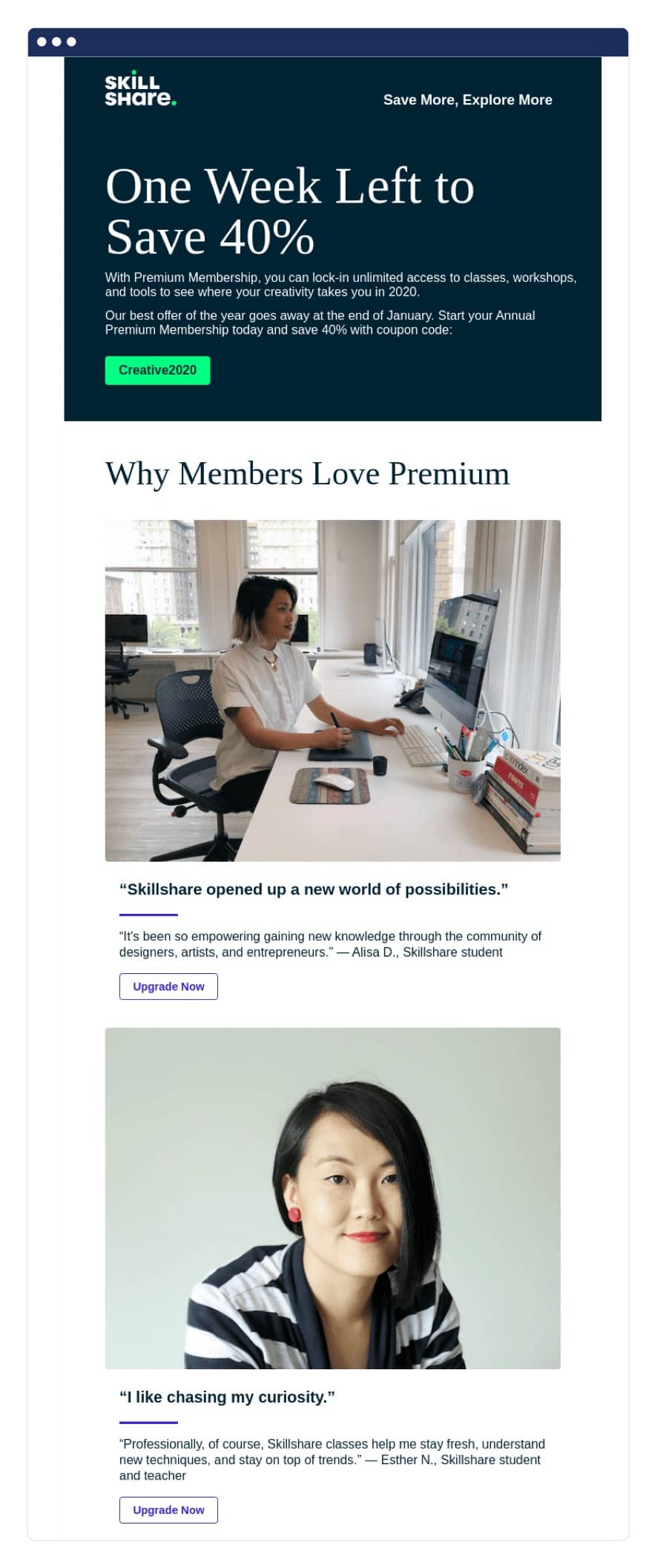
How to best track messages per subscriber
Want to find the perfect middle ground? Look at messages per subscriber, and compare that to customer engagement and conversions.
Open times
Why should you pay attention to open times?
How long after a customer abandons their cart do you send an abandoned cart email? Then, how long does the email sit in their inbox before the person opens the email? Open times give you information about how users interact with your most important messages.
What’s the best approach to tracking open times? Sure, you could use open times to determine when the best time is to send your newsletter is.
The more advanced method, though, is using open times to understand your automated campaigns.
Specifically, whether or not the timing of your automations aligns with subscriber behavior. It’s worth noting that optimizing send time for a newsletter will have a smaller impact than perfecting your customer engagements.
If you send abandoned cart emails, like the one from Society 6 below, it’s worth taking a look at open times. If there’s a trend of customers not opening the email and completing their transactions for three days after leaving your site, you may have better success delaying your automated campaign to match behavior.

Cohort analysis
Want the ultimate user-centric tool? Look no further than cohort analysis. Why cohort analysis is worth using
Do different cohorts respond to messaging differently? Is one segment more engaged than another? Using cohorts makes it easier to understand the nuances between customers.
How to perform cohort analysis Break users up into cohorts based on when they signed up, how they signed up, their segment or psychographics, or what they’ve bought in the past. Then, analyze the marketing KPIs we’ve covered within each cohort.
How should we measure email marketing performance with KPIs?
Time to get down to brass tacks—how do you actually measure these email marketing KPIs? Here are some best practices to keep in mind.
Your ESP vs. third-party tools
Your email service provider will more than likely provide you with basic email marketing KPIs. Stats such as open and click through rates are standard. However, for any analytics beyond that, you’ll need to bring in some third-party tools. Google Analytics is a popular choice for tracking conversions or visits from email.
If you want to work on custom reports or use multiple analytic tools, you’ll want to send your email data to a data warehouse, such as Redshift or Bigquery. Linking your Vero account to Stitch lets you automatically collect a range of customer actions for analysis in your data warehouse.
You can also use Segment to join together data from email, push notifications, payment apps like Stripe, and more.
Review frequency
How often you review your metrics depends on the types of KPIs you’re analyzing. For example, campaign-based KPIs such as open rates on newsletters should be reviewed after each campaign. If you’re looking at campaign metrics for automated campaigns, you may choose to pull reports each week or month.
However, user-centric KPIs and analysis are directly related to your user base. If you have a very large subscriber list, you may be able to gather accurate data daily.
Smaller companies, on the other hand, may need to wait weeks for enough data points to make an informed decision. Other factors include how long your sales cycle is and how often you make decisions based on that particular KPI.
Prioritize based on goals
There are many possibilities when it comes to email tracking and testing. While that’s exciting, it also means you need to prioritize. Start by looking at where along your email marketing funnel your performance is weakest.
If you don’t know what needs improvement, then your first task is finding it! Then, focus on user-centric KPIs that align with your priorities.
If you want to be successful in integrating more email marketing KPIs into your strategy, it pays to think holistically. As opposed to collecting an array of random metrics, consider a the user journey and what makes the most sense to track at each stage.
Vero makes tracking email performance and segments easy. Interested? Sign up for a free trial here.

